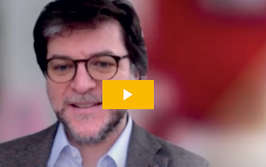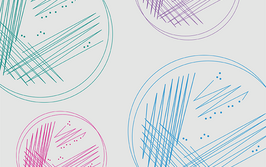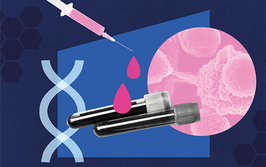
What’s a pathologist to do when, every time they look into a microscope, they are blown away by the beauty they see? Go home and paint it, of course!
Meredith Herman, pathology resident at the University of Michigan, creates beautiful paintings inspired by the images she sees in her daily training. We found out how the worlds of science and art have collided in her life.

What was your route into pathology?
From a young age, I was always artistically inclined and developed fine motor skills quickly. I would draw and color for hours, even holding art exhibits for my family when I was four years old. I continued to flourish in art through grade school, but started thinking more seriously about careers in high school. I must preface that I am the first in my family to go to medical school or pursue work in the laboratory. I realized that I enjoyed science and when I got into college at Michigan State University, I found my way into the laboratory science program. In this program, I was taught how to be a medical laboratory scientist in the hospital laboratory.
I remember my first course in lab methods, where we learned how to make peripheral smears and perform a blood cell differential under the microscope. I was captivated by the smallest of life forms in our body and the details that made them unique – I loved it.
Fortunately, I was connected with my mentor in college who also was a pathologist, and he helped me realize pathology could be a good fit for me. And so, I went into medical school knowing I wanted to do pathology, which is rare. I was the weird one who just loved being in histology lessons and studying the cells. I followed my passion and found immense support from the pathology community, and now that I am in pathology residency it feels like I am living the dream!
Can you remember how you felt when you first looked down a microscope?
When I first saw human cells under the microscope I thought it was magical – seeing life in its simplest life form was truly captivating.

But did you surprise yourself when you selected science instead of art?
As a child, I dreamed of being a fashion designer or an art teacher. Being a doctor or scientist never crossed my mind. At that age I didn't think science was very artistic. But when I started looking more into it in college, I thought, “Wow. There are a lot of visual components, details, and pattern recognition in this field.” I was particularly gifted at art, so I took that as a hint to pursue it more because it did come naturally. In retrospect, it makes total sense that I landed in medicine, especially pathology, because having a visual and artistic aptitude have helped me grow into the specialty.

So how did your pathology art come about?
Sadly, I stopped painting in college – and even in medical school. During those years, I was focused on doing well in classes. But then COVID-19 hit. When everything shut down and went virtual I thought, “What am I going to do with all this down time?” When life slowed down and I had more time for myself, I realized that I missed art and needed it back in my life. As an artist, ideas and inspiration come spontaneously and I get an urge to create. My first painting after my artistic hiatus was a microscope with pathology in the background. I went to the craft store, picked up a few materials and started painting.
When I finished, I thought, “This is pretty good!” I wondered how I could share it with others. I found the Royal College of Pathologists’ Art of Pathology Competition (rcpath.org) – and the closing date was only a week away, so I just submitted it right on time. My entry was awarded an honorable mention. This made me realize that, even though I hadn’t painted anything in a long time, perhaps I still had some talent and I should keep going. I kept practicing with watercolors during my third and fourth year of medical school. And every time I was planning what to paint, the inspiration was obvious – pathology.
I wanted to know if anyone else liked what I was creating, so I decided to put it out on Instagram and made some videos for TikTok. It really took off! I sensed some real interest and excitement about my work. So I just kept doing it!

Have you had any formal art training?
I did take some oil painting lessons before I started residency – mainly fine art and landscapes. It was fun and taught me many skills – color theory and composition, for example – that I still use and apply to my other paintings. But everything else is self taught. I took it upon myself to learn different techniques and always practice and make time for painting every day.
How would you describe your artistic work?
My medium is primarily watercolor on paper, but I also do some oil paintings. I try to illustrate what I see under the microscope – what our tissues and cells look like microscopically. And try to illuminate the patient experience, as well as disease diagnosis. I throw in some regular histology as well. I feel like my art should be described as “where science meets art.” I think it’s a skill to be able to blend those two things artistically. People don’t usually get to see their cells under the microscope, so that’s what I’m able to bring to them. And if people comment that the images are beautiful or mesmerizing, I can ask, “What makes it beautiful? What catches your eye?” For most people it’s just that they have never seen cells and tissues as art, but now they can see the beauty.

How else do you get your work seen?
I sell my work via an online store. Occasionally I do commissions. I also donate pieces to good causes; I donated a painting to a fundraiser for breast cancer and plan to do more. I get to use my work in a philanthropic way, it’s my hobby, and it’s my side gig – it’s a win–win situation.
Tell us about the pathology art community – and how you connect with them.
#pathart has been used for quite a while on social media – both for real laboratory images that people find particularly beautiful or representative of a disease, and for painted images. The hashtag is already used widely on X (formerly Twitter) and Instagram, and is starting to gain more traction on TikTok. More people are becoming interested and there are more emerging artists as a result – both painters and digital artists. Pathologists and laboratory scientists alike enjoy art and have always shown support in my artistic pursuits.
The platform I use depends on the media I want to share. If it is a process video, I will create it on TikTok (@meredithkheman). If I have a static photo of a painting I did or want to make a trendy short reel, I post it on Instagram. It is important to be present and accessible on social media. I like to connect with other artists and engage with my followers. I frequently get messages from people around the world about how my art inspired them to paint or create something pathological. I think it is important to also support other artists with shared interests by promoting their content, interacting with them, and collaborating with them!

What advice would you give to other artists who would like their work to be seen?
The first step is to put yourself out there. Don’t be afraid to publish your work and to show it around. You’ll find a very supportive community. It’s also good to show your process; for example, make a video and put it on TikTok, Instagram, X, YouTube, etc. Experiment with different platforms and styles and find the way you want to express yourself.
In your experience, do laboratory medicine professionals tend to be artistically inclined?
There is a visual aspect to pathology. We need to be detail-oriented to pick up patterns to connect pieces, and to have puzzle-solving capabilities. Not every pathologist will claim they are artistic, but I do believe we all use our right-brain whether we know it or not. I think there is a propensity for pathologists to be more artistically inclined; however, it doesn’t have to be painting – I’ve seen people doing woodworking, sculpture, and pottery. Everyone in the lab has their own hobby and there is often an artistic element to it.

What does the artistic process mean for you, personally?
It’s very relaxing – but it’s also essential to my wholeness as a person. I can’t believe there was a time when I didn’t paint. I just put it off and thought, “I have to study, I have to do other things.” But I realized that doing art is important for my sanity in a stressful profession or with a stressful school workload. It’s also my business, so I have orders to fulfill. More generally, I think it’s very healthy to have a creative outlet. My husband finds it funny that I go to work and then get home and go straight to my other work. But when I get an idea for a painting in my head, I just want to work on it straight away and get it out there. I have an art studio set up at home so that everything is ready to go. I take my art seriously just as I take my residency training seriously.
Credit: Supplied by the Interviewee
Combining my dual backgrounds in science and communications to bring you compelling content in your speciality.




















